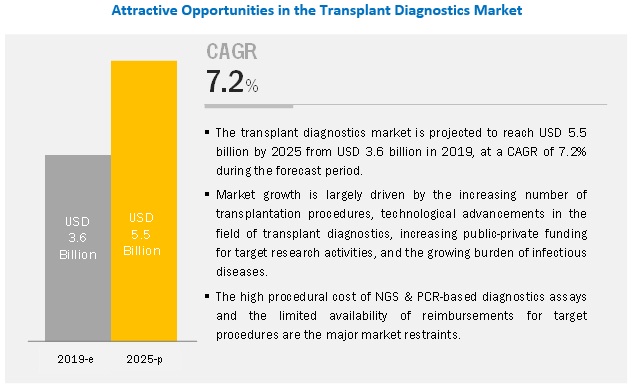What This Report Will Provide?
The study involved four major activities in estimating the current size of the transplant diagnostics market. Exhaustive secondary research was conducted to collect information on the market and its different subsegments. The next step was to validate these findings, assumptions, and sizing with industry experts across the value chain through primary research.
Both top-down and bottom-up approaches were employed to estimate the total market size. After that, market breakdown and data triangulation were used to estimate the market size of segments and subsegments.
Expected Revenue Growth:
[227 Pages Report] The transplant diagnostics market is expected to reach USD 5.5 billion by 2025 from USD 3.6 billion in 2019, at a CAGR of 7.2%.

Major Growth Boosters:
The demand for transplant diagnostic products is expected to grow mainly due to factors such as the increasing public-private funding for target research activities, the growing burden of infectious diseases, the increasing number of transplant procedures, and technological advancements in the field of transplant diagnostics.
is expected to reach USD 5.5 billion by 2025 from USD 3.6 billion in 2019, at a CAGR of 7.2%.
Major Growth Boosters:
The demand for transplant diagnostic products is expected to grow mainly due to factors such as the increasing public-private funding for target research activities, the growing burden of infectious diseases, the increasing number of transplant procedures, and technological advancements in the field of transplant diagnostics.
The market, by technology, is segmented into molecular and non-molecular assay technologies. In 2019, the molecular assay technologies segment accounted for the largest share of the market.
Download PDF Brochure:
https://www.marketsandmarkets.com/pdfdownloadNew.asp?id=41882774
Recent Developments (2016-2019):
- In August 2019, Care Dx (US) acquired XynManagement (US) to simplify transplant quality tracking and waitlist management.
- In March 2019, Hologic established a learning and experience center in Zaventem (Belgium) to create awareness among customers, healthcare professionals, and employees across Europe, the Middle East, and Africa about the benefits of diagnostic products, including transplant diagnostic products.
- In February 2019, Care Dx (US) launched the Allosure for lung transplants.
- In January 2018, F. Hoffman-LA Roche Limited (Switzerland) launched the Cobas Plasma Separation Card.
Key Questions Addressed in The Report:
- What are the growth opportunities related to the adoption of transplant diagnostic products across significant regions in the future?
- Emerging countries show immense opportunities for the growth and adoption of transplant diagnostic instruments, related reagents & consumables, and software. Will this scenario continue in the next five years?
- Where will the advancements in products offered by various companies take the industry in the mid- to long-term?
- What are the newest trends and advancements in the transplant diagnostics market?
Request Sample Report: https://www.marketsandmarkets.com/requestsampleNew.asp?id=2531061
The molecular assay technologies segment accounted for the largest share of the transplant diagnostics market, by technology, in 2019
The market, by technology, is segmented into molecular and non-molecular assay technologies. In 2019, the molecular assay technologies segment accounted for the largest share of the market. The large share of this segment can be attributed to the benefits offered by molecular assays such as low turnaround time, high procedural efficacy, the study of multiple samples, and real-time sample analysis.
Regional Growth Analysis:
North America is a well-established market for medical devices. The presence of a highly developed healthcare system, high adoption of innovative transplant diagnostic technologies among medical professionals, the large volume of organ transplantation procedures performed in the region, and technological advancements in the field of transplant diagnostics are the major factors driving the market in North America.
